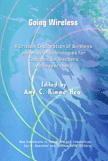Part I: Refiguring Writing, Teaching, and Learning through Wireless and Mobile Technologies
In the opening chapter of Going Wireless, "The Changing Shapes of Writing: Rhetoric, New Media, and Composition," Johndan Johnson-Eilola and Stuart Selber seem to be responding primarily to theorists and writing teachers still holding the line that newer forms of communication such as texting and instant messaging are "ruining" writing, and to those writing teachers reluctant to include newer writing technologies into their classes. Early in the chapter, they tell us that
Questions about whether or not new forms such as IM and Short Message Service (SMS) hurt writing are beside the point: They're already here—and our students are using them on a daily basis. (p. 16)
What they propose is expanding how we define genre to include these new forms of writing by suggesting a broader theoretical framework. This framework is composed of the following elements which they see as comprising any writing situation: Context, Change, Content, and Tools. These elements are intended to be broad enough to include traditional forms of classroom writing, such as the essay, as well as forms of writing such as instant messaging (IM) and short messaging service (SMS) that right now exist outside of the classroom. This broad framework will help students and teachers see the ways that writing practice is tied to material situations and technologies, providing a rhetorical understanding of our various literacy practices.
What I see as their most important contribution is their call to "give up the notion that teachers must be masters of all terrain that the course covers" in order that we might "understand our expertise in different more useful ways" (p. 18). This statement is a reminder that no matter how theoretically opposed we might be to banking-model pedagogies, the myth of total expertise can undo our best efforts, and that new communications technologies can offer us an opportunity to engage with our students as fellow learners.
In "Learning Unplugged," Teddi Fishman and Kathleen Blake Yancey ask what it means for the writing classroom when what is considered traditionally "other" to our classroom writing practices is suddenly admitted. The answer to the question is similar to Johnson-Eilola's and Selber's approach to wireless technology in that Fishman and Yancey see new communication technologies as potentially beneficial rather than automatically an impediment to good instruction and good writing. Specifically, they ask us to consider the possibility that
When the availability of virtually unlimited information is a given, but the quality, applicability, veracity, and authenticity must be investigated, pedagogy changes from "what do you know?" to "how do you know" or "how can we know?" or "what can we do with what we know?" Particularly when students are expected to generate information as well as consume it [...] access to multiple resources can expand, deepen, and complicate both what is known and how what is known comes to be known. (p. 37, emphasis original)
Taken this way, mobile and wireless technologies become not only useful in the composition classroom, but an imperative. After all, the questions Fishman and Yancey point to are the very questions we hope our students ask when they approach their writing projects. These are the questions that have always been the exigence for writing.
Agree or not, the point is that the information context created by ambient connectivity brings these questions to the surface, making it seem impossible to deny engagement with this context in the first-year writing classroom.
